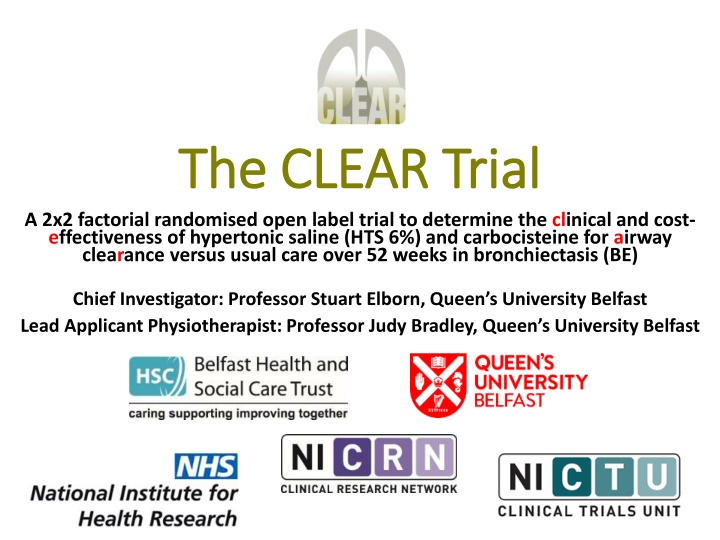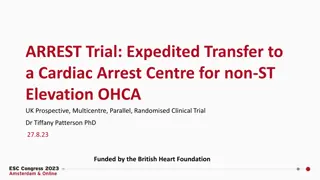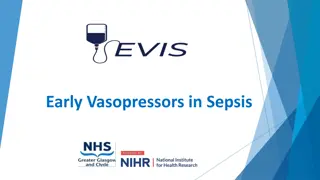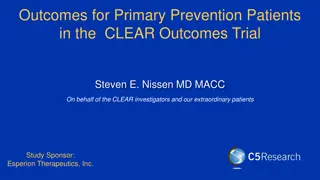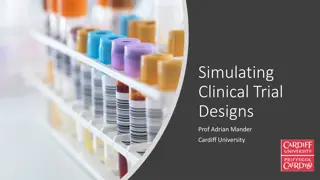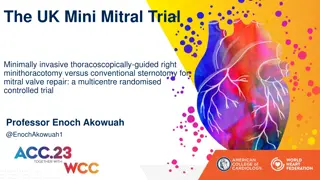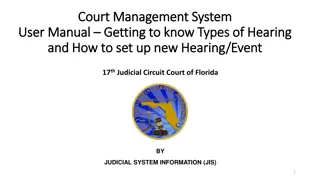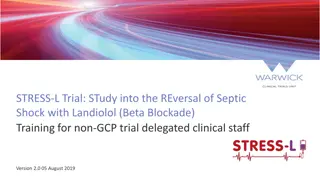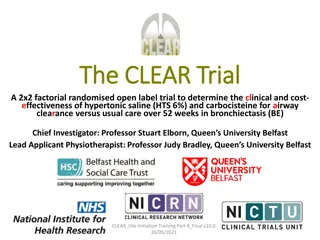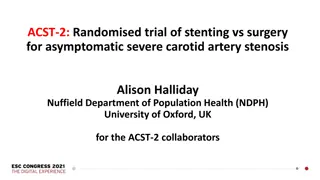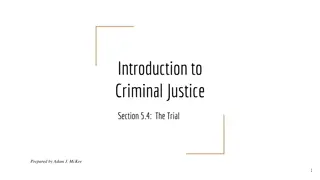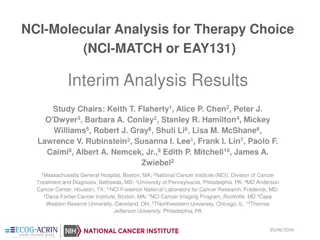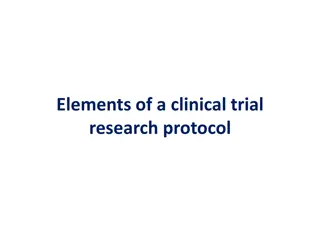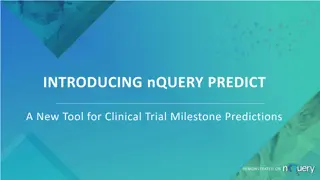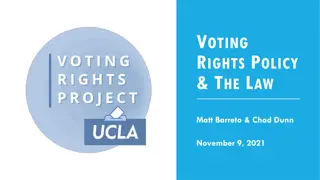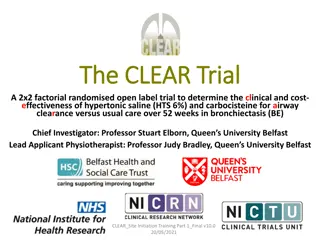The CLEAR Trial
This content provides details on the Drug Response Assessment (DRA) in the CLEAR Trial, a 2x2 factorial randomized trial focusing on the clinical and cost-effectiveness of hypertonic saline and carbocisteine for airway clearance in bronchiectasis patients over 52 weeks. The sections cover reasons for conducting the DRA, necessary documents, training, interpretation of results, competency assessment, and preparation steps. The aim is to assess hyperresponsiveness to determine suitability for the study based on airway responses to stimuli. Detailed guidance is given on equipment setup, procedural steps for the DRA, and adherence to local guidelines during the assessment.
Download Presentation

Please find below an Image/Link to download the presentation.
The content on the website is provided AS IS for your information and personal use only. It may not be sold, licensed, or shared on other websites without obtaining consent from the author.If you encounter any issues during the download, it is possible that the publisher has removed the file from their server.
You are allowed to download the files provided on this website for personal or commercial use, subject to the condition that they are used lawfully. All files are the property of their respective owners.
The content on the website is provided AS IS for your information and personal use only. It may not be sold, licensed, or shared on other websites without obtaining consent from the author.
E N D
Presentation Transcript
The CLEAR Trial The CLEAR Trial A 2x2 factorial randomised open label trial to determine the clinical and cost- effectiveness of hypertonic saline (HTS 6%) and carbocisteine for airway clearance versus usual care over 52 weeks in bronchiectasis (BE) Chief Investigator: Professor Stuart Elborn, Queen s University Belfast Lead Applicant Physiotherapist: Professor Judy Bradley, Queen s University Belfast
Site Initiation Training Part 5: Drug Response Site Initiation Training Part 5: Drug Response Assessment Assessment - - Clinical Clinical
Drug Response Assessment Drug Response Assessment In this section we will explain the: Reason for a DRA in the CLEAR study Documents provided for the DRA Training to be able to conduct the DRA Interpretation of the results Appropriate documentation of the outcome Competency assessment Pre-reading of associated documents: i. CLEAR Study: Drug Response Assessment Guideline with Proforma for 6% Hypertonic Saline ii. CLEAR Study: Drug Response Assessment Competency Document
Drug Response Assessment Drug Response Assessment To assess hyper responsiveness (an exaggerated response of the airways to the stimulus i.e. to HTS) leading to bronchoconstriction which could render the individual unsuitable for this study i.e. >15% drop in FEV1 UNLIKELY
Drug Response Assessment Drug Response Assessment
Drug Response Assessment Drug Response Assessment Step 1: Preparation Step 1: Preparation Obtain the DRA Proforma for 6% HTS Collect and set-up the equipment: eFlow rapid nebuliser system and eTrack controller Study spirometer (SpiroSensePro) Oxygen saturation monitor Collect the 6% HTS (4 ml ampoule) Collect bronchodilator Describe the DRA procedure Give advice and education on nebuliser or dry powder inhaler (DPI) technique Please remember to follow local guidelines on PPE/infection control when performing a DRA
Drug Response Assessment Drug Response Assessment MucoClear MucoClear 6% HTS Request 6% HTS Request Form Form If in accordance with local processes, a 20-ampoule box of MucoClear HTS 6% may be released from pharmacy supplies and held by the clinical team for the DRA An example pharmacy request form for MucoClear is available that may be adapted for local use
Drug Response Assessment Drug Response Assessment Bronchodilator Request Form Bronchodilator Request Form An example pharmacy request form is available for salbutamol that may be adapted for local use.
Drug Response Assessment Drug Response Assessment Step 2: Administer Pre Step 2: Administer Pre- -Test Bronchodilator (if required) Test Bronchodilator (if required) If the patient is routinely prescribed a short acting bronchodilator (e.g. 200 mcg salbutamol MDI) then they should also be asked to bring this with them to the baseline visit and they should take a pre-test dose 5-10 minutes before the baseline spirometry and HTS administration. If the patient has not brought their routine bronchodilator to the visit then one should be prescribed to be taken 5-10 mins before the HTS administration. If the patient is not usually prescribed a bronchodilator, then the HTS can be given without a pre-test bronchodilator. However the research team must have access to a post-test bronchodilator i.e. Salbutamol 100 mcg, to use in the incidence of symptomatic bronchoconstriction (>15% drop in FEV1, or 10-15% with adverse symptoms). Follow your local processes for access to a post-test bronchodilator. An example pharmacy prescription form is available that may be adapted locally.
Drug Response Assessment Drug Response Assessment Step 3: Pre Step 3: Pre- -Trial Assessment Trial Assessment Check patient for clinical stability Feeling more unwell Haemoptysis Increase in steroid medication or Any recent contraindications to spirometry (e.g. chest pain, sinus surgery) Complete FEV1/FVC Best of 3 FEV1 measurements recorded including % predicted Advise patient if they feel nauseous, light headedness, tight in the chest or generally feel unwell when taking the nebuliser or DPI to tell you immediately
Drug Response Assessment Drug Response Assessment Step 4: Administration of the HTS Step 4: Administration of the HTS Monitor oxygen saturation and HR throughout procedure Give the HTS 6% via the eFlow rapid nebuliser If saturation falls below normal levels (for the patient) for a consistent period, reassess the patients breathing pattern. If this consistent low oxygen saturation persists, then the test should be stopped and a re-trial should be considered as per the DRA proforma and flow diagram During the test and immediately post inhalation, ask the patient to describe any symptoms e.g. chest tightness Stop immediately if the patient feels chest tightness, breathlessness or wheeze, lip or tingling in mouth or throat tightness, as this could be the sign of anaphylaxis If so inform the medical team for an immediate review Repeat FEV1/FVC measurements
Drug Response Assessment Drug Response Assessment Step 5: Analysis for Possible Bronchospasm Step 5: Analysis for Possible Bronchospasm Once the reduction in FEV1 has recovered to 10% or less from baseline and the patient is not symptomatic then the monitoring can be stopped If the patients FEV1 drop remains persistently above 10% from baseline, seek medical review for the patient and continue to monitor them closely Any other scenario outside of those discussed above should be discussed with the PI for further guidance
Drug Response Assessment Drug Response Assessment Step 6: Review Results Step 6: Review Results Calculate amount of constriction (if any): Pre FEV1- Post FEV1X 100 = % Constriction Pre FEV1
Drug Response Assessment Drug Response Assessment Step 7: Review Results Step 7: Review Results If post inhalation of the HTS the FEV1has not reduced by more than 10% this is a PASS If post inhalation of the HTS the FEV1 has reduced by between 10-15% and the are no adverse symptoms associated (such as wheeze and irritable cough) then it is suitable for use and a PASS If post inhalation of the HTS the FEV1 has reduced by between 10-15% and there ARE adverse symptoms associated (such as wheeze and irritable cough) then this is a FAIL If post inhalation of the HTS the FEV1has reduced by more than 15%, then this is a FAIL and the patient should be closely monitored for deterioration Repeat FEV1 should be taken after 10 minutes and FEV1 change from baseline re-calculated. If 10 minutes after inhalation of the HTS the FEV1 remains reduced more than 15%, the researcher should administer the post test bronchodilator prescribed and monitor the patient closely throughout and repeat the FEV1 again after a further 10 minutes
Drug Response Assessment Drug Response Assessment Step 8: Re Step 8: Re- -Assess if Required Assess if Required Consider if test dose to be repeated (discuss with the investigator) Consider if repeat test requires pre-treatment with a bronchodilator If a bronchodilator is required to enable a patient to pass a re- test the patient should be prescribed salbutamol 100 mcg, 2 puffs prior to each HTS administration during the study treatment period. Repeat testing can be considered on the same day (discuss with the investigator) once FEV1 has returned to within 5% of baseline, or a repeat test can be booked on a separate day. If the test is not within a 2-week timeframe baseline assessment should be repeated.
Drug Response Assessment Drug Response Assessment Step 9: Document Outcome of DRA Step 9: Document Outcome of DRA After the DRA is completed and the result confirmed, this should be recorded on the DRA form. All discussions should be documented clearly on the DRA Form Complete the relevant part of the CRF to indicate the outcome of the DRA
Examples of calculations Calculate amount of constriction (if any): Pre FEV1 - Post FEV1X 100 = % Constriction Pre FEV1 Case Studies Pre FEV1 L/min (FEV1% pred) Post FEV1 L/min (FEV1 % pred) Patient 1 2.0 (76%) 1.95 Patient 2 4.2 (69%) 3.6 Patient 3 4.2 (69%) 3.6 (symptoms) Patient 4 2.0 (76%) 1.5
Drug Response Assessment Drug Response Assessment Patient 1 Answer Calculate amount of constriction (if any): 2.0 1.95 L/min X 100 = 2.5% Constriction 2.0 Pass
Drug Response Assessment Drug Response Assessment Patient 2 - Answer Calculate amount of constriction (if any): 4.2 3.6 L/min X 100 = % Constriction 4.2 Pass 0.6 L/min X 100 = 14.3 % Constriction plus no adverse symptoms 4.2
Drug Response Assessment Drug Response Assessment Patient 3 Answer Calculate amount of constriction (if any): 4.2 3.6 L/min X 100 = % Constriction 4.2 Fail 0.6 L/min X 100 = 14.3 % Constriction, plus symptoms (e.g. wheeze, 4.2 irritable cough)
Drug Response Assessment Drug Response Assessment Patient 4 Answer Calculate amount of constriction (if any): Fail 2.0 1.5 L/min X 100 = 25% Constriction 2.0
Drug Response Assessment Drug Response Assessment DRA Competency paperwork is required Completed separately with Prof Bradley in a 10-15 minute telecon
FAQ FAQ A patient is prescribed a bronchodilator but does not regularly use it. Should the patient take his/her bronchodilator before HTS administration during the DRA? If the patient is not supposed to use their bronchodilator regularly then the HTS can be administered without a pre-test bronchodilator. You may need to check with the clinical team whether they should be using their bronchodilator. Ensure you have a bronchodilator during the test to use in the incidence of symptomatic bronchoconstriction and follow the DRA Guideline
